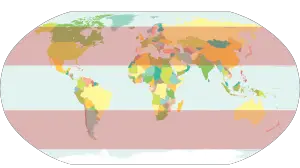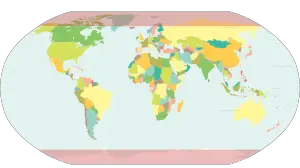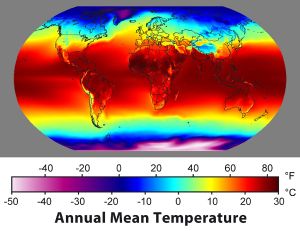Difference between revisions of "Geographical zone" - New World Encyclopedia
Mary Anglin (talk | contribs) m |
Mary Anglin (talk | contribs) m |
||
| Line 12: | Line 12: | ||
*The South Frigid Zone, south of the Antarctic Circle | *The South Frigid Zone, south of the Antarctic Circle | ||
| + | ==Zones== | ||
In the Torrid Zone, also known as the [[Tropics]], the sun is directly overhead at least once during the year - at the edges of the tropics this occurs at the summer [[solstice]], and over the [[equator]], at the [[equinoxes]]. This is the hottest part of the earth, and there are two annual seasons: a dry and a wet. The Torrid Zone includes most of [[Africa]], southern [[India]], southern [[Asia]], [[Indonesia]], [[New Guinea]], northern [[Australia]], southern [[Mexico]], [[Central America]] and northern [[South America]]. | In the Torrid Zone, also known as the [[Tropics]], the sun is directly overhead at least once during the year - at the edges of the tropics this occurs at the summer [[solstice]], and over the [[equator]], at the [[equinoxes]]. This is the hottest part of the earth, and there are two annual seasons: a dry and a wet. The Torrid Zone includes most of [[Africa]], southern [[India]], southern [[Asia]], [[Indonesia]], [[New Guinea]], northern [[Australia]], southern [[Mexico]], [[Central America]] and northern [[South America]]. | ||
Revision as of 09:01, 6 January 2009
Each of the five main latitude regions of the earth's surface is said to be a geographical zone, divided by the major circles of latitude. The differences between them relate to climate, and the behavior of the sun. They are as follows:
- The North Frigid Zone, north of the Arctic Circle
- The North Temperate Zone, between the Arctic Circle and the Tropic of Cancer
- The Torrid Zone, between the Tropics of Cancer and Capricorn
- The South Temperate Zone, between the Tropic of Capricorn and the Antarctic Circle
- The South Frigid Zone, south of the Antarctic Circle
Zones
In the Torrid Zone, also known as the Tropics, the sun is directly overhead at least once during the year - at the edges of the tropics this occurs at the summer solstice, and over the equator, at the equinoxes. This is the hottest part of the earth, and there are two annual seasons: a dry and a wet. The Torrid Zone includes most of Africa, southern India, southern Asia, Indonesia, New Guinea, northern Australia, southern Mexico, Central America and northern South America.
In the two Temperate Zones, the sun is never directly overhead, and the climate is mild, generally ranging from warm to cool. The four annual seasons, Spring, Summer, Autumn and Winter occur in these areas. The North Temperate Zone includes Great Britain, Europe, northern Asia, North America and northern Mexico. The South Temperate Zone includes southern Australia, New Zealand, southern South America and South Africa.
The two Frigid Zones, or polar regions, experience the midnight sun and the polar night for part of the year - the edge of the zone experiences one day at the solstice when the sun doesn't rise or set for 24 hours, while in the center of the zone (the pole), the day is literally one year long, with six months of daylight and six months of night. The Frigid Zones are the coldest parts of the earth, and are covered with ice and snow. The North Frigid Zone (the Arctic) includes northern Canada and Alaska, Greenland, northern Scandinavia, northern Russia, and the Arctic ice. The South Frigid Zone (The Antarctic) is filled by the continent of Antarctica; the next closest mainland is the southern tip of Chile and Argentina, followed byNew Zealand.
The edges of the Temperate Zones are also sometimes referred to as the Subtropics, Subarctic and Subantarctic.
History
The idea of a geographical zone was first hypothesized by the ancient Greek scholar Aristotle. He said that the earth was divided into three types of climatic zones, based on their distance from the equator.
Thinking that the area near the equator was too hot for habitation, Aristotle dubbed the region around the equator (from 23.5° N to 23.5° S) as the "Torrid Zone." He reasoned that from the Arctic Circle to the pole was permanently frozen. He called this uninhabitable zone the "Frigid Zone." The only area that Aristotle believed was livable was the "Temperate Zone", lying between the "Frigid Zone" and the "Torrid Zone". One of the reasons Aristotle believed that the Temperate Zone was the best for life possibly stems from the fact that he lived in that zone.
As knowledge of the earth's geography improved, a second "Temperate Zone" was discovered south of the equator, and a second "Frigid Zone" was discovered around the Antarctic. It is understood today that Aristotle's map was vastly oversimplified, although the general idea was correct.
Modern climatic systems
Today, the most commonly used climate map is the Köppen climate classification, developed by German climatologist and amateur botanist Wladimir Köppen (1846-1940). It is based on the concept that native vegetation is the best expression of climate; thus, climate zone boundaries have been selected with vegetation distribution in mind. It combines average annual and monthly temperatures and precipitation, and the seasonality of precipitation. The Köppen climate classification scheme divides the climates into five main groups and several types and subtypes. The Köppen classification includes climate regimes such as rainforest, monsoon, tropical savanna, humid subtropical, humid continental, oceanic climate, Mediterranean climate, continental steppe, subarctic climate, tundra, polar ice cap, and desert.
The Köppen system, however, has its drawbacks. A modified version of the Köppen system known as the Trewartha climate classification scheme attempts to redefine the broad climatic groups in such a way as to be closer to vegetational zoning, especially in the United States. Under the standard Köppen system western Washington and Oregon are classed into the same climate as southern California, even though the two regions have strikingly different vegetation. It also classes southern New England into the same climate as the Gulf Coast. Trewartha's modifications sought to reclassify the Pacific Northwest seaboard as a different climate from California, and New England from the Gulf Coast.
ReferencesISBN links support NWE through referral fees
- Akin, Wallace E. 1991. Global patterns: climate, vegetation, and soils. Norman: University of Oklahoma Press. ISBN 9780806123097
- Aquado, Edward and James Burt. 2006. Understanding Weather and Climate, 4th ed. Upper Saddle River, NJ: Pearson Prentice Hall. ISBN 0131496964.
- Brummitt, R.K. August 2001. World Geographical Scheme for Recording Plant Distributions Hunt Institute for Botanical Documentation, Carnegie Mellon University. Retrieved January 6, 2009.
- McKnight, Tom L. 1984. Physical geography: a landscape appreciation. Englewood Cliffs, N.J.: Prentice-Hall. ISBN 9780136691013
- Times Books (New York, N.Y.), and Bartholomew (Firm). 1999. The Times atlas of the world. New York: Times Books. ISBN 9780812932652
- Frodin, David G. 2001. Guide to the standard floras of the world. Cambridge: CUP. ISBN 9780521790772
| Regions of the world | |||||||||||||||||||||||||
|---|---|---|---|---|---|---|---|---|---|---|---|---|---|---|---|---|---|---|---|---|---|---|---|---|---|
|
| ||||||||||||||||||||||||
| See also Continents of the world | |||||||||||||||||||||||||
Credits
New World Encyclopedia writers and editors rewrote and completed the Wikipedia article in accordance with New World Encyclopedia standards. This article abides by terms of the Creative Commons CC-by-sa 3.0 License (CC-by-sa), which may be used and disseminated with proper attribution. Credit is due under the terms of this license that can reference both the New World Encyclopedia contributors and the selfless volunteer contributors of the Wikimedia Foundation. To cite this article click here for a list of acceptable citing formats.The history of earlier contributions by wikipedians is accessible to researchers here:
The history of this article since it was imported to New World Encyclopedia:
Note: Some restrictions may apply to use of individual images which are separately licensed.




